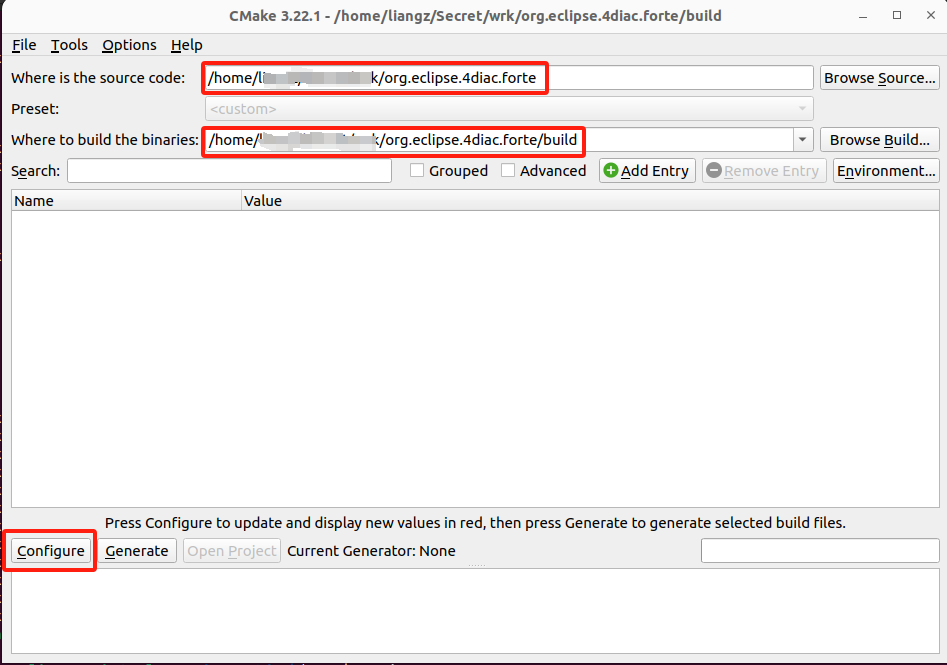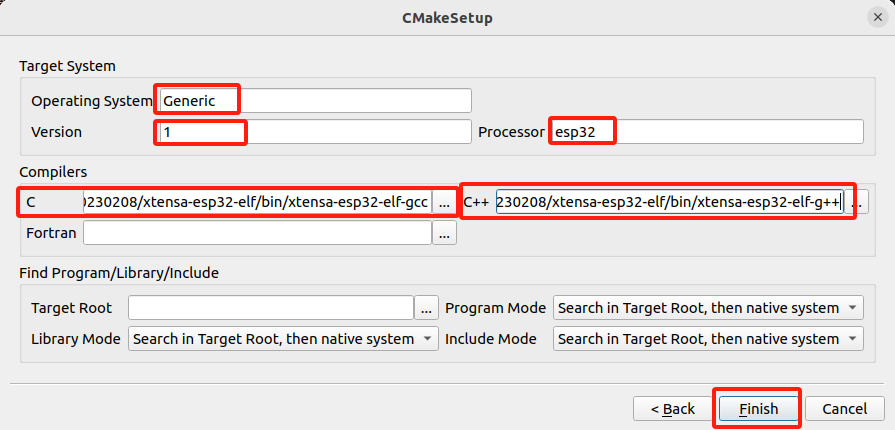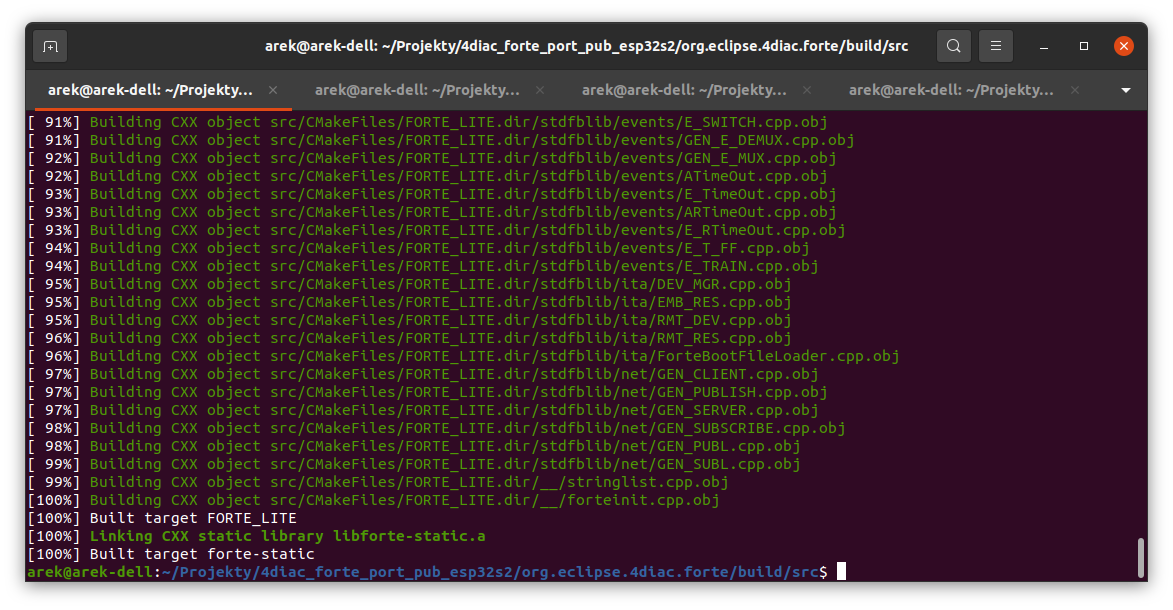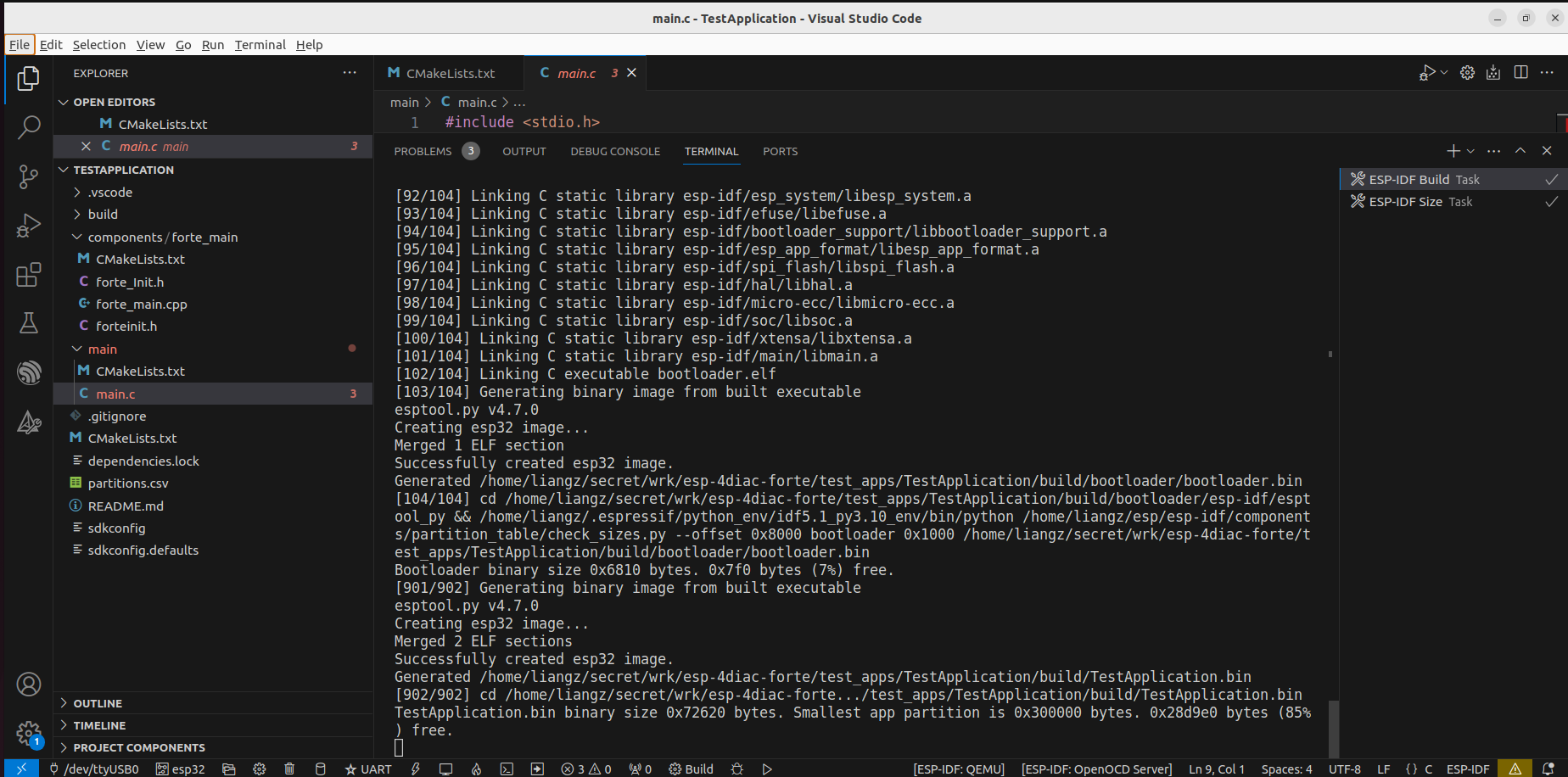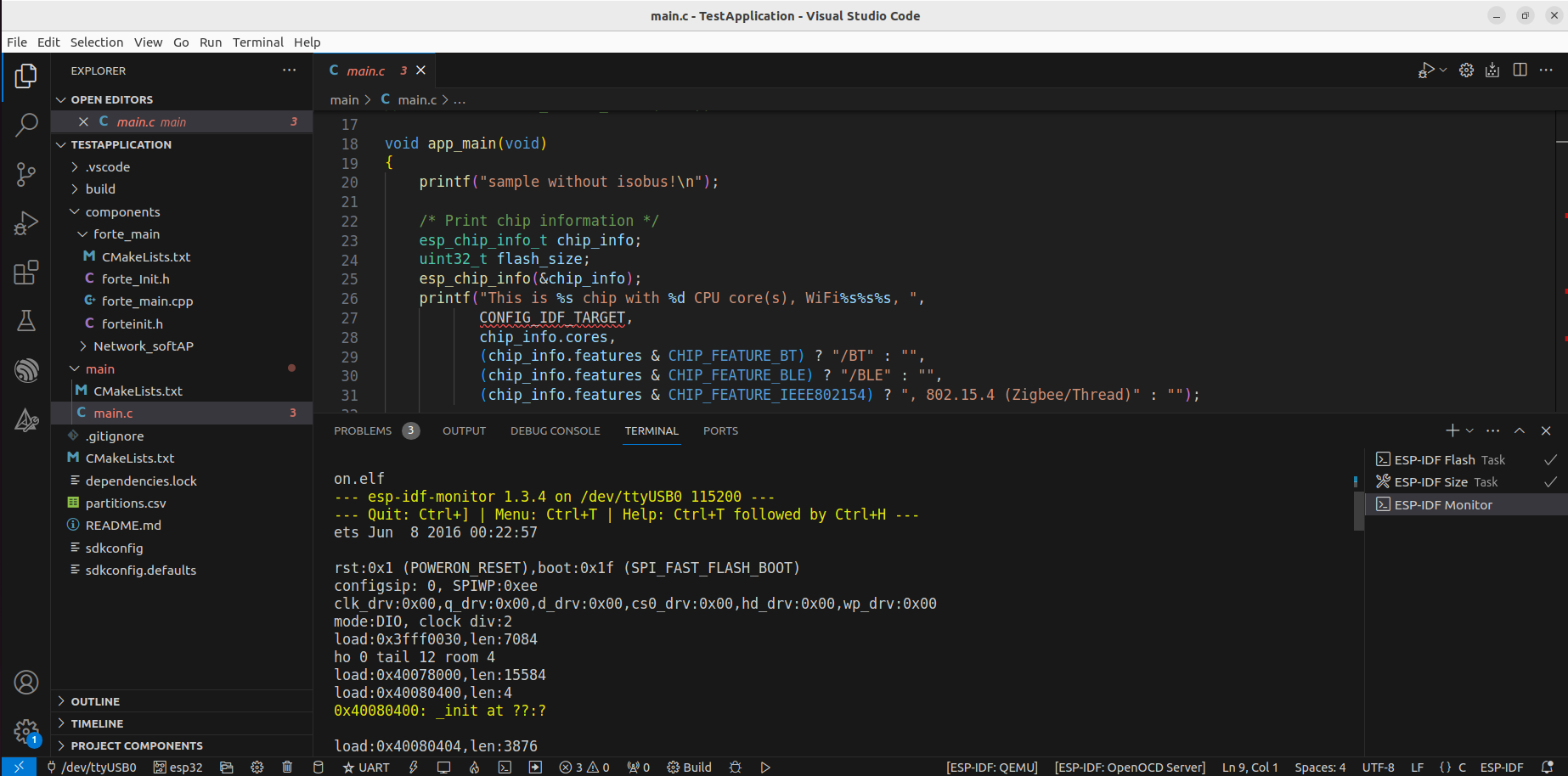- ESP 4diac FORTE Library
ESP-4diac-FORTE is a standard ESP-IDF component.
4diac FORTE is an open source PLC runtime framework based on IEC 61499 standard. This how-to describes how to run it on esp32 or esp32s2 mcu. For more details about 4diac FORTE please visit https://www.eclipse.org/4diac/en_rte.php.
This library is based on:
- Linux operating system - Ubuntu / Debian / Arch.
- Visual Studio Code.
- with Espressif plugin for ESP32 chips support -
Espressif IDF, install and setup the extension. - ESP-IDF - should be installed by VS Code plugin.
- Git, make, cmake and cmake-gui:
sudo apt-get install git make cmake cmake-gui
Also it is assumed that user has basic knowledge about C/C++ programming, esp32 platform and required toolchains.
It is good to test all nessecery tools before proced this instruction.
Clone latest 4diac FORTE repository:
$ git clone https://git.eclipse.org/r/4diac/org.eclipse.4diac.forte.gitIt is important to have it in some accesible place so we can easly come back to it. For propose of this text, /home/liangz/secret/wrk/ has been used.
-
Open CMake-GUI In next step in forte root folder create build directory and launch cmake gui tool. It can be done via terminal command
$ cmake-gui
-
Complete as shown in the image
- Set the 4diac FORTE source path where you cloned the Git repository, e.g.:
/home/liangz/secret/wrk/org.eclipse.4diac.forte. - Set path for binaries where you want to create the library, e.g.:
/home/liangz/secret/wrk/org.eclipse.4diac.forte/build.Normally, bin/freeRTOS is used. - Press Configure and new window will appear with configuration wizard.
- Set the 4diac FORTE source path where you cloned the Git repository, e.g.:
-
In new window, select the correct option
- Select the tool you normally use to compile your programs. This example follows using
UNIX Makefilesfrom the list. - Select
Specify options for cross-compiling. - Press Next->
- Select the tool you normally use to compile your programs. This example follows using
-
Setup for cross-compilation. You have to select GCC and G++ compilers for xtensa atchitecture
- Write Operating System to Generic (normally freeRTOS, it won't affect the compilation)
- Write Processor to esp32 or esp32s2
- Select the path of the C cross-compiler to /home/liangz/.espressif/tools/xtensa-esp32-elf/esp-12.2.0_20230208/xtensa-esp32-elf/bin/xtensa-esp32-elf-gcc
- Select the path of the C++ cross-compiler to /home/liangz/.espressif/tools/xtensa-esp32-elf/esp-12.2.0_20230208/xtensa-esp32-elf/bin/xtensa-esp32-elf-g++
- The target root field can be left empty.
- Click Finish
A list with all variables of 4diac FORTE in red should be shown in CMake.
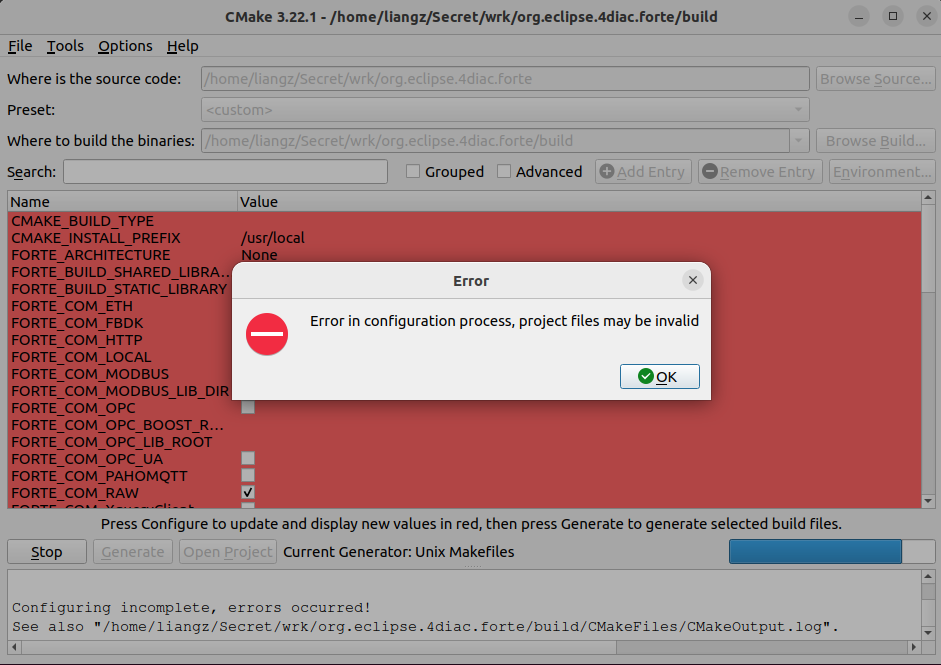
-
For esp32 we have to set the
FORTE_ARCHITECTUREvariable toFreeRTOSLwIP. Now when click Configure, most errors should dissapear.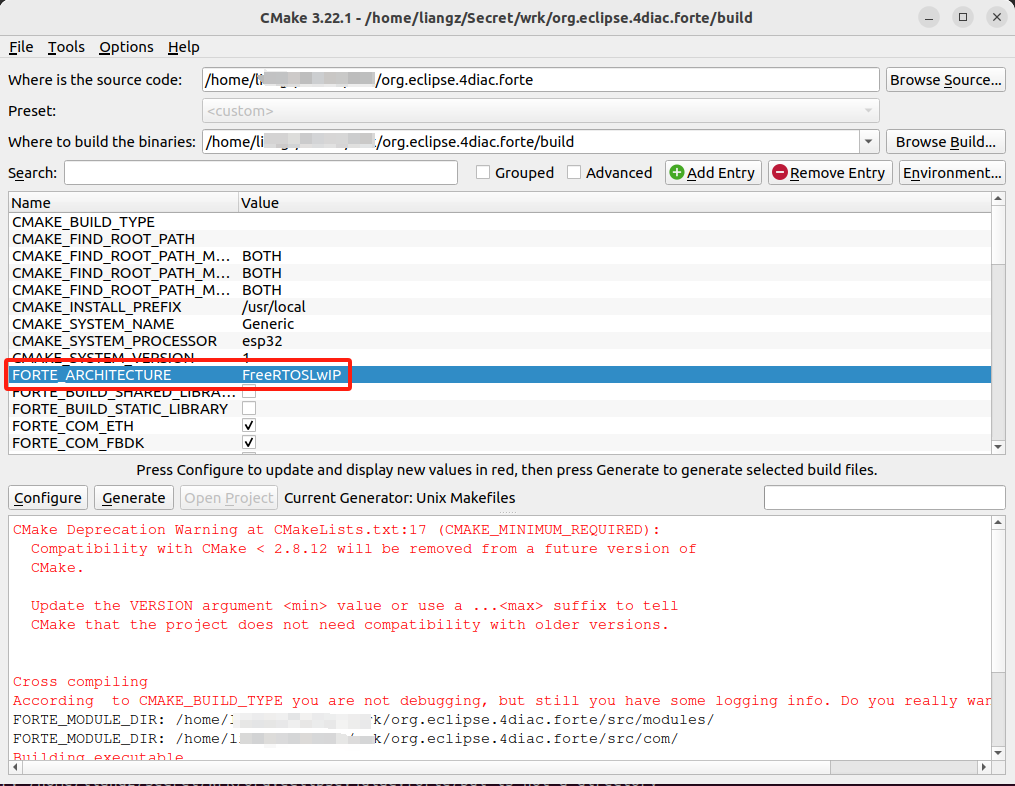
-
Check the information that appears in CMake about the LwIP configuration.
-
The variable
FORTE_FreeRTOSLwIP_INCLUDESshould appear now and it is the most important one. You should set it to the several paths where the freeRTOS and LwIP headers are, each separated by a semicolon. For example:${MAIN_DIRECTORY}/FreeRTOS/portable;${MAIN_DIRECTORY}/include;${MAIN_DIRECTORY}/lwip/src/include;${MAIN_DIRECTORY}/lwip/portwhere${MAIN_DIRECTORY}is the path where you have your freeRTOS and LwIP code. When you later compile and it fails with an error saying that some "includes" are missing, this variable should be updated where the folders where the missing files are located. ParameterFORTE_FreeRTOSLwIP_INCLUDEShas to be set. It takes string with semicolon separated paths to include folders in esp-idf. There is quite a lot of paths that have to be added as include paths. Below there is a working configuration, please note that all of those paths are absolue so you need to modify all of them. In most cases it should be enought to repleace all occurrences of/home/liangz/esp/esp-idfwith your ESP-IDF root directory path. For example with/home/my_user/my_projects/my-idf_path./home/liangz/test/blink/build/config;/home/liangz/esp/esp-idf/components/newlib/platform_include;/home/liangz/esp/esp-idf/components/freertos/FreeRTOS-Kernel/include;/home/liangz/esp/esp-idf/components/freertos/FreeRTOS-Kernel/include/freertos;/home/liangz/esp/esp-idf/components/freertos/FreeRTOS-Kernel/portable/xtensa/include;/home/liangz/esp/esp-idf/components/freertos/esp_additions/include/freertos;/home/liangz/esp/esp-idf/components/freertos/esp_additions/include;/home/liangz/esp/esp-idf/components/freertos/esp_additions/arch/xtensa/include;/home/liangz/esp/esp-idf/components/esp_hw_support/include;/home/liangz/esp/esp-idf/components/esp_hw_support/include/soc;/home/liangz/esp/esp-idf/components/esp_hw_support/include/soc/esp32;/home/liangz/esp/esp-idf/components/esp_hw_support/port/esp32/.;/home/liangz/esp/esp-idf/components/esp_hw_support/port/esp32/private_include;/home/liangz/esp/esp-idf/components/heap/include;/home/liangz/esp/esp-idf/components/log/include;/home/liangz/esp/esp-idf/components/soc/include;/home/liangz/esp/esp-idf/components/soc/esp32;/home/liangz/esp/esp-idf/components/soc/esp32/include;/home/liangz/esp/esp-idf/components/hal/esp32/include;/home/liangz/esp/esp-idf/components/hal/include;/home/liangz/esp/esp-idf/components/hal/platform_port/include;/home/liangz/esp/esp-idf/components/esp_rom/include;/home/liangz/esp/esp-idf/components/esp_rom/include/esp32;/home/liangz/esp/esp-idf/components/esp_rom/esp32;/home/liangz/esp/esp-idf/components/esp_common/include;/home/liangz/esp/esp-idf/components/esp_system/include;/home/liangz/esp/esp-idf/components/esp_system/port/soc;/home/liangz/esp/esp-idf/components/esp_system/port/include/private;/home/liangz/esp/esp-idf/components/xtensa/include;/home/liangz/esp/esp-idf/components/xtensa/esp32/include;/home/liangz/esp/esp-idf/components/lwip/include;/home/liangz/esp/esp-idf/components/lwip/include/apps;/home/liangz/esp/esp-idf/components/lwip/include/apps/sntp;/home/liangz/esp/esp-idf/components/lwip/lwip/src/include;/home/liangz/esp/esp-idf/components/lwip/port/include;/home/liangz/esp/esp-idf/components/lwip/port/freertos/include;/home/liangz/esp/esp-idf/components/lwip/port/esp32xx/include;/home/liangz/esp/esp-idf/components/lwip/port/esp32xx/include/arch
Note: replace
/home/liangz/test/blink/build/configwith your path ofsdkconfig.h.
-
It might be the case that you also need to set the
CMAKE_C_FLAGSandCMAKE_CXX_FLAGSvariables with the flags needed for your hardware. You can check which flags you need from the proeperties of your example project in your cross-IDE.Once you have filed freertos includes you have add few additional compiler flags. To do this you need to activate
Advancedcheckbox in upper right corner of cmake program. Once you have it, you will be able to see much more options that you can tweak.Flags that you have to add:
-mlongcalls -ffunction-sections -fdata-sections -fno-threadsafe-statics -fno-rtti -fno-exceptions -DconfigMINIMAL_STACK_SIZE_FORTE=15000All of them have to be added to all variants of
CMAKE_C_FLAGSandCMAKE_CXX_FLAGS. There are:DEBUG, MINISIZEREL RELEASE, REALWITHDEBINFOIt should looks similar to picture below.
-
Next option to set is the
FORTE_TicksPerSecondoption to 100 instead of 1000. It is also visible in advanced mode. -
We also need to tell cmake that we want to build static library instead of execurable. To do this you have to set
FORTE_BUILD_EXECUTABLEto false/deselect andFORTE_BUILD_STATIC_LIBRARYto true/select. -
For first tests, it is good to enable debug feature in FORTE so we can see more logs. That is very usefull during first run so we can see that everything works as it should. To do this, in
CMAKE_BUILD_TYPEtype:DEBUGand switchFORTE_LOGLEVELtoLOGDEBUG. UnfortunetlyFORTE_LOGLEVELoptions automaticly switch back toNOLOGeverytime we trigger configuration, so it's important to remember about it when we do some changes and we expect to have logs.
- Click Configure and the variables that need revision will appear again in red and the rest in white.
Check these variables and press Configure until no variable is shown in red. Here you can add the modules that you want FORTE to have, but from the freeRTOS point of view, there's nothing else you need.
Just to highlight changes that we have done here:
FORTE_ARCHITECTUREset toFreeRTOSLwIPFORTE_FreeRTOSLwIP_INCLUDESfillup all FreeRTOS include pathsCMAKE_C_FLAGS,CMAKE_CXX_FLAGSand their variations withDEBUG, MINISIZEREL RELEASE, REALWITHDEBINFO- add compilers flags.FORTE_TicksPerSecondset to 100FORTE_BUILD_EXECUTABLEdeselectFORTE_BUILD_STATIC_LIBRARYselectCMAKE_BUILD_TYPEtypeDEBUG,FORTE_LOGLEVELset toLOGDEBUG
- Click Generate
-
Go to the recently generated folder (e.g.:
${FORTE_ROOT}/build/src) and typemake -jyour make tool should start doing all the jobs and as a result,$ cd ${FORTE_ROOT}/build/src # cd bin/freeRTOS $ make -j
-
If you got an error, check again the variables in CMake, specially
FORTE_FreeRTOSLwIP_INCLUDES,CMAKE_C_FLAGSandCMAKE_CXX_FLAGS. -
If no error occurred, after some small amount of time, you should have builded FORTE static library like on the picture below:
-
Now you can find your static library in
${FORTE_ROOT}/build/srcbin/freeRTOS/srclibforte-static.a. We will use this library to prepare our ESP component so it can be used directly in the esp project.
Go to your working directory and type:
$ cd <your-working-directory>
$ git clone https://github.com/hikiku/esp-4diac-forte.gitAt this moment you can copy you static library to the FORTE component folder.
It's good to make a symbolic link instead of hard copy of static library. To do this you can use ln command in your shell.
ln -s [soruce file] [destination file]
for example:
$ cd <your-working-directory>/esp32-4diac-forte/lib/esp32/src
$ mv libforte-static.a libforte-static.a.origin
$ ln -s <your-working-directory>/org.eclipse.4diac.forte/build/src/libforte-static.a libforte-static.aIn this way you don't have to copy the library everytime you rebuild it.
To test you FORTE buld, you need eighter prepare your sample aplication from scratch or use the one that has been already prepared. This how-to will not cover how to make new project from scratch, instead we will use here an already prepared example - <your_working_dicrotry>/esp-4diac-forte/test_apps/TestApplication/.
Open your Visual Studio Code, and load this 4diac FORTE example application project.
If you have everything properly installed project should build without any issues. Once you build it, flash and turn on ESP-IDF Monitor device.
Once it's done you should see your 4diac FORTE up and running.
-
CTRL+Shift+P ->
ESP-IDF:>Set Espressif device target -
(Optional) Configure your SPI Flash: CTRL+Shift+P ->
ESP-IDF:>SDK Configuration Editor (menuconfig):Serial flasher config -> Flash SPI speed (40 MHz) -> Flash size (4 MB) -
(Optional) Edit your partion file of SPI flash -
partion.csv:# Name, Type, SubType, Offset, Size, Flags # Note: if you have increased the bootloader size, make sure to update the offsets to avoid overlap nvs, data, nvs, 0x9000, 0x6000, phy_init, data, phy, 0xf000, 0x1000, factory, app, factory, 0x10000, 3M, storage, data, spiffs, , 0xF0000, -
CTRL+Shift+P ->
ESP-IDF:>Build your project -
CTRL+Shift+P ->
ESP-IDF:>Select Port to Use(COM,tty,usbserial) -
CTRL+Shift+P ->
ESP-IDF:>Flash your project -
CTRL+Shift+P ->
ESP-IDF:>Monitor your projectets Jun 8 2016 00:22:57 rst:0x1 (POWERON_RESET),boot:0x1f (SPI_FAST_FLASH_BOOT) configsip: 0, SPIWP:0xee clk_drv:0x00,q_drv:0x00,d_drv:0x00,cs0_drv:0x00,hd_drv:0x00,wp_drv:0x00 mode:DIO, clock div:2 load:0x3fff0030,len:7084 ho 0 tail 12 room 4 load:0x40078000,len:15584 load:0x40080400,len:4 0x40080400: _init at ??:? load:0x40080404,len:3876 entry 0x4008064c I (31) boot: ESP-IDF v5.1.2-dirty 2nd stage bootloader I (31) boot: compile time Feb 4 2024 12:55:18 I (31) boot: Multicore bootloader I (36) boot: chip revision: v1.0 I (40) boot.esp32: SPI Speed : 40MHz I (44) boot.esp32: SPI Mode : DIO I (49) boot.esp32: SPI Flash Size : 4MB I (54) boot: Enabling RNG early entropy source... I (59) boot: Partition Table: I (63) boot: ## Label Usage Type ST Offset Length I (70) boot: 0 nvs WiFi data 01 02 00009000 00006000 I (77) boot: 1 phy_init RF data 01 01 0000f000 00001000 I (85) boot: 2 factory factory app 00 00 00010000 00300000 I (92) boot: 3 storage Unknown data 01 82 00310000 000f0000 I (100) boot: End of partition table I (104) esp_image: segment 0: paddr=00010020 vaddr=3f400020 size=26954h (158036) map I (170) esp_image: segment 1: paddr=0003697c vaddr=3ffb0000 size=03c4ch ( 15436) load I (176) esp_image: segment 2: paddr=0003a5d0 vaddr=40080000 size=05a48h ( 23112) load I (186) esp_image: segment 3: paddr=00040020 vaddr=400d0020 size=aa750h (698192) map I (438) esp_image: segment 4: paddr=000ea778 vaddr=40085a48 size=10838h ( 67640) load I (478) boot: Loaded app from partition at offset 0x10000 I (478) boot: Disabling RNG early entropy source... I (489) cpu_start: Multicore app I (490) cpu_start: Pro cpu up. I (490) cpu_start: Starting app cpu, entry point is 0x400813fc 0x400813fc: call_start_cpu1 at /home/liangz/esp/esp-idf/components/esp_system/port/cpu_start.c:157 I (0) cpu_start: App cpu up. I (507) cpu_start: Pro cpu start user code I (508) cpu_start: cpu freq: 160000000 Hz I (508) cpu_start: Application information: I (512) cpu_start: Project name: TestApplication I (518) cpu_start: App version: 14d6a8b-dirty I (523) cpu_start: Compile time: Feb 4 2024 13:27:56 I (529) cpu_start: ELF file SHA256: 41063bad2d5194cf... I (535) cpu_start: ESP-IDF: v5.1.2-dirty I (541) cpu_start: Min chip rev: v0.0 I (545) cpu_start: Max chip rev: v3.99 I (550) cpu_start: Chip rev: v1.0 I (555) heap_init: Initializing. RAM available for dynamic allocation: I (562) heap_init: At 3FFAE6E0 len 00001920 (6 KiB): DRAM I (568) heap_init: At 3FFB8610 len 000279F0 (158 KiB): DRAM I (575) heap_init: At 3FFE0440 len 00003AE0 (14 KiB): D/IRAM I (581) heap_init: At 3FFE4350 len 0001BCB0 (111 KiB): D/IRAM I (587) heap_init: At 40096280 len 00009D80 (39 KiB): IRAM I (595) spi_flash: detected chip: generic I (598) spi_flash: flash io: dio I (606) app_start: Starting scheduler on CPU0 I (607) app_start: Starting scheduler on CPU1 I (607) main_task: Started on CPU0 I (617) main_task: Calling app_main() sample without isobus! This is esp32 chip with 2 CPU core(s), WiFi/BT/BLE, silicon revision v1.0, 4MB external flash Minimum free heap size: 274828 bytes CONFIG_FREERTOS_HZ: 1000 must be 1000 !!!! (200Hz at least for 5ms ) app_main starting I (664) wifi softAP: ESP_WIFI_MODE_AP I (669) wifi:wifi driver task: 3ffc0f90, prio:23, stack:6656, core=0 I (680) wifi:wifi firmware version: 91b9630 I (681) wifi:wifi certification version: v7.0 I (681) wifi:config NVS flash: enabled I (681) wifi:config nano formating: disabled I (685) wifi:Init data frame dynamic rx buffer num: 32 I (690) wifi:Init static rx mgmt buffer num: 5 I (694) wifi:Init management short buffer num: 32 I (698) wifi:Init dynamic tx buffer num: 32 I (702) wifi:Init static rx buffer size: 1600 I (706) wifi:Init static rx buffer num: 10 I (710) wifi:Init dynamic rx buffer num: 32 I (715) wifi_init: rx ba win: 6 I (718) wifi_init: tcpip mbox: 32 I (722) wifi_init: udp mbox: 6 I (726) wifi_init: tcp mbox: 6 I (729) wifi_init: tcp tx win: 5744 I (733) wifi_init: tcp rx win: 5744 I (738) wifi_init: tcp mss: 1440 I (742) wifi_init: WiFi IRAM OP enabled I (746) wifi_init: WiFi RX IRAM OP enabled W (1003) wifi:Configuring PMF required implicitly for authmode WIFI_AUTH_WPA3_PSK I (1006) phy_init: phy_version 4780,16b31a7,Sep 22 2023,20:42:16 I (1083) wifi:mode : softAP (bc:dd:c2:d1:be:b1) I (1222) wifi:Total power save buffer number: 16 I (1223) wifi:Init max length of beacon: 752/752 I (1224) wifi:Init max length of beacon: 752/752 I (1227) wifi softAP: wifi_init_softap finished. SSID:ESP_D1BEB1 password:esp32_pwd channel:1 I (1228) esp_netif_lwip: DHCP server started on interface WIFI_AP_DEF with IP: 192.168.4.1 I (1243) MAIN: Executing forte... I (1257) MAIN: OK 0 , Could start forte forte_main done I (3243) main_task: Returned from app_main()
Now you can deploy your sample application. To build your sample application with FORTE please refer to FORTE documentation : Step 1 - Use 4diac Locally (Blinking Tutorial)
If everything is done correctly you should succesfully deploy your application. Enjoy!
